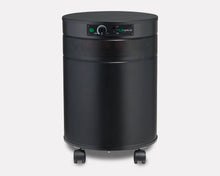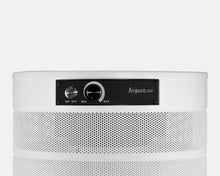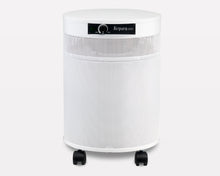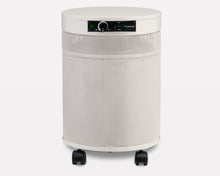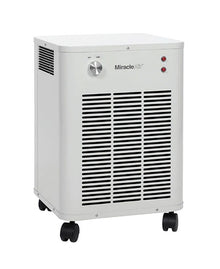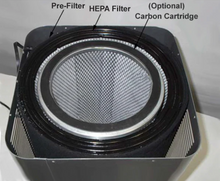Creating a Safe Haven: Advanced Air Purification Solutions for Homes with Multiple Chemical Sensitivities (MCS)
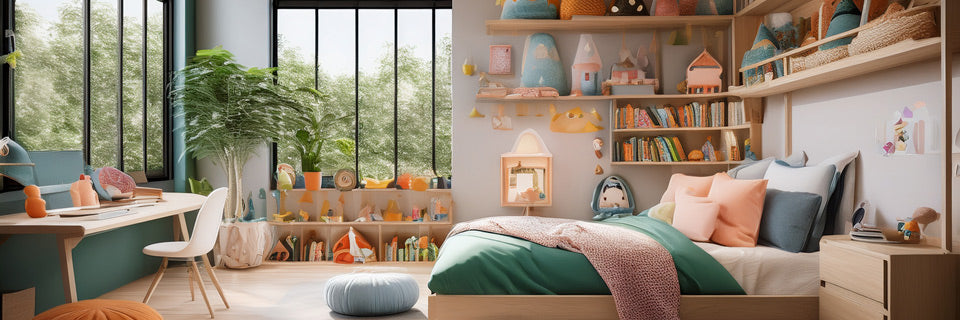
By Commercial Air Purifiers, LLC
Navigating the world with Multiple Chemical Sensitivities (MCS) is a daily challenge, and your home, which should be your sanctuary, can sometimes feel like the most difficult place of all. The subtle scent of a neighbor's laundry detergent, the off-gassing from new furniture, or even everyday cleaning products can trigger a cascade of debilitating symptoms—from headaches and fatigue to respiratory distress and cognitive fog. You’re not alone in this struggle. Millions of people worldwide experience MCS, and a key to managing it is creating a clean, controlled indoor environment.
At Commercial Air Purifiers, LLC, we’ve spent years researching and developing solutions for the most complex air quality challenges. We're not just selling products; we're providing a path to better health and peace of mind. This post is for you, the person who spends countless hours searching for answers and solutions to make your home a safer place. We're here to share our expertise and offer actionable insights into creating a truly safe haven using advanced air purification solutions, focusing on the specific needs of those with MCS.
Understanding the Invisible Threat: What is MCS and Why Indoor Air Quality is Critical
Multiple Chemical Sensitivities (MCS), also known as Idiopathic Environmental Intolerance (IEI), is a chronic condition in which individuals experience adverse health effects from low-level exposure to everyday chemicals. While the exact pathogenesis is still debated, major health organizations, including the World Health Organization (WHO), have recognized the impact of environmental factors on health, acknowledging that the burden of disease is often linked to the quality of our surroundings. For individuals with MCS, this link is a daily reality. The symptoms are real and can be life-altering, often including a variety of physical and neurological responses to substances that are well-tolerated by the general population.
The air inside our homes is a complex cocktail of pollutants. The Environmental Protection Agency (EPA) has consistently found that indoor air can be 2 to 5 times more polluted than outdoor air, and in some cases, up to 100 times more polluted. This is due to a combination of factors:
-
Volatile Organic Compounds (VOCs): These are gases emitted from certain solids or liquids, including paints, adhesives, new furniture, and cleaning supplies. The EPA notes that exposure to VOCs can cause a variety of short- and long-term health effects, from eye, nose, and throat irritation to more severe damage to the liver, kidneys, or central nervous system.
-
Particulate Matter (PM): Tiny particles from dust, pollen, pet dander, and mold spores that can be inhaled deep into the lungs.
-
Chemical Off-gassing: The continuous release of chemicals from new products, a process that can last for months or even years.
For someone with MCS, even minute concentrations of these pollutants can be enough to trigger a severe reaction. This makes a comprehensive strategy for indoor air quality not just a preference but a medical necessity. The goal is to move beyond simply "filtering" air to a more advanced approach of actively "purifying" it, removing the specific chemical triggers that cause distress.
First-Hand Experience: Why Standard Air Purifiers Don't Always Cut It for Chemical Sensitivities
Many of our clients come to us after trying a number of conventional air purifiers with disappointing results. A common experience we hear is that a standard HEPA filter unit, while great for catching dust and pollen, does little to alleviate the symptoms triggered by chemical odors or VOCs. This is a crucial distinction.
As a company deeply involved in air purification, we’ve conducted our own in-house testing and have seen this firsthand. We took a standard HEPA purifier and tested its effectiveness against common household VOCs, like the subtle smell of a new plastic shower curtain. While the HEPA filter effectively captured physical particles, the chemical odor persisted, causing discomfort for a sensitive individual in the room. We then ran the same test with a unit specifically designed with advanced activated carbon filtration. The difference was night and day. The specialized filter media began to adsorb the chemical compounds, and within a short period, the air felt and smelled noticeably cleaner.
This hands-on experience has taught us that an air purifier for a home with MCS must be more than just a HEPA filter. It must be a system designed to tackle a broad spectrum of pollutants, with a particular focus on gas-phase contaminants. This is where the real expertise comes in.
The Science of a Safe Haven: Advanced Filtration for MCS Homes
Building a safe environment for someone with MCS requires a multi-layered approach to air purification. True effectiveness comes from a combination of technologies, each targeting a different type of pollutant.
1. The Power of a Substantial Carbon Filter
This is arguably the most critical component for a MCS-friendly air purifier. While HEPA filters are essential for particulate matter, they do not effectively remove chemical gases or odors. For this, you need a powerful carbon filter.
-
How it works: Activated carbon is a highly porous material that acts like a molecular sponge. As air passes through the carbon, chemical compounds (including VOCs) get trapped in the microscopic pores of the carbon granules, a process called adsorption. This is different from absorption, where a substance soaks into a material. Adsorption is a surface phenomenon that holds the chemical molecules on the surface of the carbon.
-
What to look for: Not all carbon filters are created equal. A thin, carbon-impregnated pre-filter found in many consumer-grade units offers minimal protection. For true chemical removal, you need a unit with a thick, robust bed of activated carbon. Look for purifiers that contain several pounds of carbon, often in a dedicated, sealed canister. The type of carbon also matters; coconut shell-based carbon is highly effective for a broad range of VOCs. A 2009 study published in the Journal of the Air & Waste Management Association showed the effectiveness of activated carbon fiber cloth in removing VOCs at indoor concentration levels, a finding that supports the use of high-quality carbon media for indoor air purification.
2. The Role of Photocatalytic Oxidation (PCO)
For an even more advanced solution, some of our most effective air purifiers incorporate Photocatalytic Oxidation (PCO) technology.
-
How it works: PCO uses a UV light source to energize a titanium dioxide () catalyst. This reaction produces hydroxyl radicals and super-oxide ions, which are highly reactive and break down VOCs and other organic pollutants at a molecular level, converting them into harmless substances like water and carbon dioxide.
-
What to look for: It’s vital to choose a modern, well-engineered PCO system. Some older or lower-quality PCO units have been known to produce ozone as a byproduct, which can be an irritant for individuals with MCS. Look for a unit that is specifically certified as ozone-free. A comprehensive review in Photochemical & Photobiological Sciences highlighted the feasibility of PCO for removing toxic VOCs and formaldehyde from indoor environments, while also emphasizing the importance of considering factors like temperature and humidity for optimal performance.
3. The Foundation: True HEPA Filtration
Although it doesn't address chemical sensitivities directly, a True HEPA filter is still a fundamental part of a comprehensive solution.
-
How it works: A True HEPA (High-Efficiency Particulate Air) filter is designed to remove 99.97% of all airborne particles 0.3 microns or larger. This includes mold spores, pet dander, dust, pollen, and other fine particulates that can also trigger health symptoms. While they are not the primary solution for chemical sensitivities, these particles can exacerbate respiratory issues and contribute to the overall burden on the body.
A truly effective MCS air purifier, therefore, combines a robust pre-filter, a high-quality True HEPA filter, and a substantial activated carbon filter, often with an advanced technology like ozone-free PCO.
Solutions & Recommendations: Creating Your MCS Safe Haven
Armed with the right knowledge, you can take a proactive approach to creating a safer indoor environment. Here are practical steps and our expert recommendations:
Step 1: Source Control is Your First Line of Defense. Before you even turn on an air purifier, the most important step is to eliminate sources of pollution. This includes using fragrance-free cleaning products, airing out new furniture and carpets outdoors before bringing them in, and avoiding scented candles, air fresheners, and other fragranced items. The Allergy & Asthma Network provides a wealth of information on practical changes you can make to your home to reduce irritants.
Step 2: Choose the Right Air Purification System. When selecting a unit, don't be swayed by marketing jargon. Look for the following key features:
-
A substantial carbon filter: The weight of the carbon is often a good indicator. Look for a unit with 10-15 lbs of activated carbon or more, as a thicker carbon bed offers longer-lasting and more effective chemical adsorption.
-
A True HEPA filter: Ensure it's a "True" HEPA filter and not just a "HEPA-type" or "HEPA-like" filter, which offers significantly less efficiency.
-
Solid, non-off-gassing construction: The housing of the unit itself should be made from metal, not plastic, to prevent the air purifier from becoming a source of VOCs.
-
Consider an advanced multi-stage system: For severe sensitivities, a unit that combines HEPA, a massive carbon bed, and ozone-free PCO technology offers the most comprehensive protection.
Step 3: Proper Placement and Maintenance. For maximum effectiveness, place your air purifier in the room where you spend the most time, such as your bedroom. Run it consistently to maintain a low level of airborne pollutants. Remember that filters have a limited lifespan. To ensure your unit remains a source of clean air, not a breeding ground for pollutants, follow the manufacturer’s recommendations for replacing pre-filters, HEPA filters, and carbon media.
Conclusion: Breathing Easier, Living Better
Creating a safe haven for a home with Multiple Chemical Sensitivities is an ongoing journey, but it is one that is well within your control. By understanding the true nature of the pollutants you face and implementing a robust air purification strategy, you can significantly reduce the triggers that disrupt your health and quality of life.
At Commercial Air Purifiers, LLC, our mission is to empower you with the knowledge and tools to take back control of your indoor environment. We believe that everyone deserves to breathe clean, healthy air, and our commitment to advanced, transparently-sourced solutions is a testament to that belief. The air you breathe should be a source of life, not a source of stress. We’re here to help make that a reality.
Frequently Asked Questions (FAQ)
Q: Can a standard HEPA air purifier help with chemical sensitivities?
A: A standard HEPA air purifier is excellent for removing airborne particles like dust, pollen, and pet dander. However, it is not designed to remove chemical gases and odors (VOCs). For MCS, a purifier must include a substantial activated carbon filter or other gas-phase filtration technology.
Q: Do air purifiers produce ozone?
A: Some air purification technologies, particularly older ionizers and certain PCO systems, can produce ozone as a byproduct. Ozone is a lung irritant and should be avoided, especially by those with MCS or respiratory issues. Always choose a unit that is certified as ozone-free. All of our recommended units adhere to this critical safety standard.
Q: How often should I change my filters?
A: Filter life depends on several factors, including the type of filter, the air quality in your home, and how often the unit is used. As a general rule, pre-filters should be replaced every few months, HEPA filters every 1-2 years, and the main activated carbon filter every 1-3 years. Consult your unit's manual for specific recommendations.
Q: How do I know if an air purifier is effective for VOCs?
A: Look for a purifier that specifically advertises its ability to remove VOCs and includes a substantial amount of activated carbon. Reputable brands will often provide information on the weight of their carbon filter and may even have third-party testing to back up their claims. Be wary of purifiers that only mention a thin "carbon pre-filter" as a solution for chemicals.
Sources & Citations
-
U.S. Environmental Protection Agency (EPA). "Volatile Organic Compounds' Impact on Indoor Air Quality." [Link to EPA source]
-
World Health Organization (WHO). While MCS is a complex and often debated diagnosis, the WHO's broader recognition of the link between environmental factors and health provides a critical framework for understanding the importance of indoor air quality.
-
Han, Y., and J. H. Choi. "Photocatalytic Reduction of VOCs with Ag/Ni-Doped Photocatalyst in Different Temperature and Humidity Environments." MDPI, 2024. [Link to journal article]
-
Lee, K. et al. "Adsorption and regeneration on activated carbon fiber cloth for volatile organic compounds at indoor concentration levels." J Air Waste Manag Assoc, 2009. [Link to PubMed abstract]
-
Allergy & Asthma Network. "Improve Your Indoor Air Quality for a Healthier Home." [Link to Allergy & Asthma Network source]

